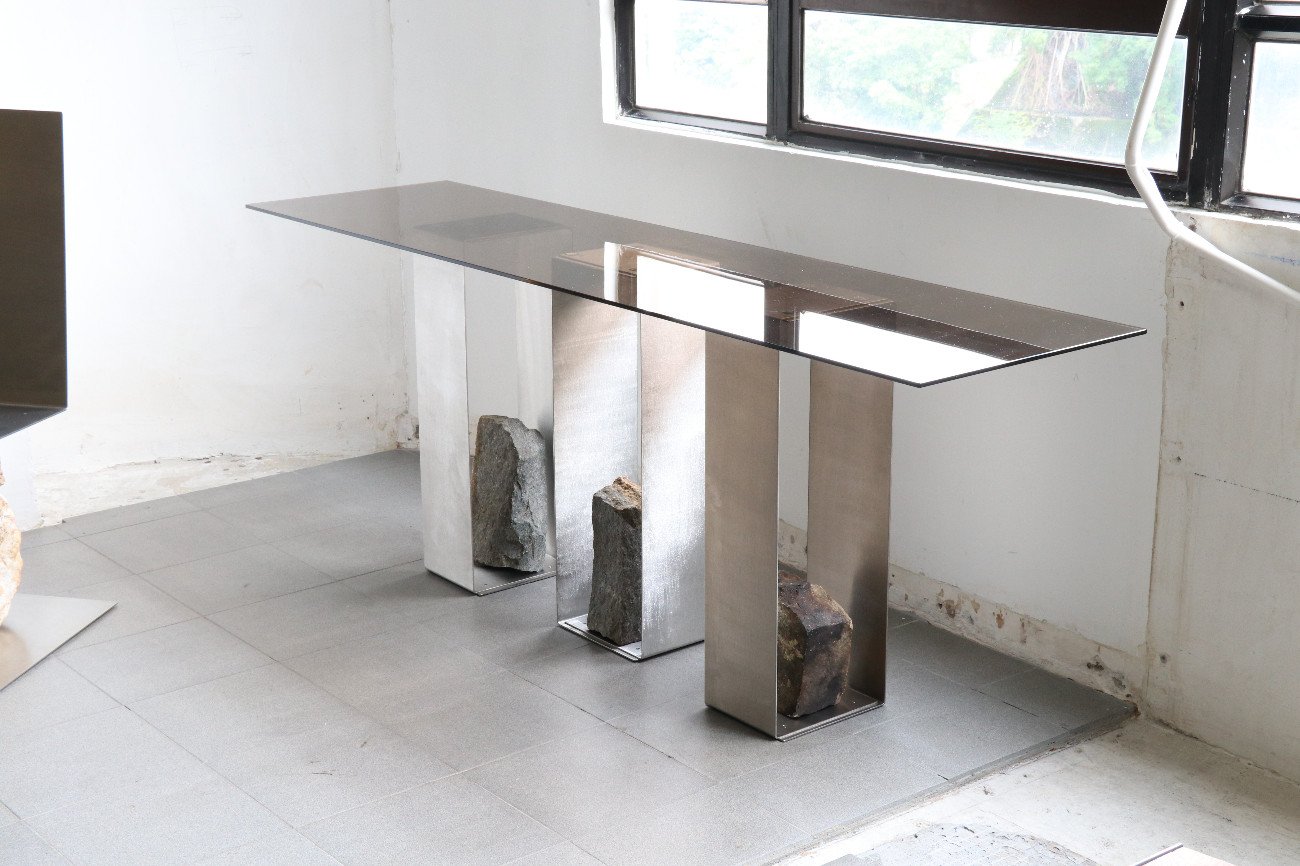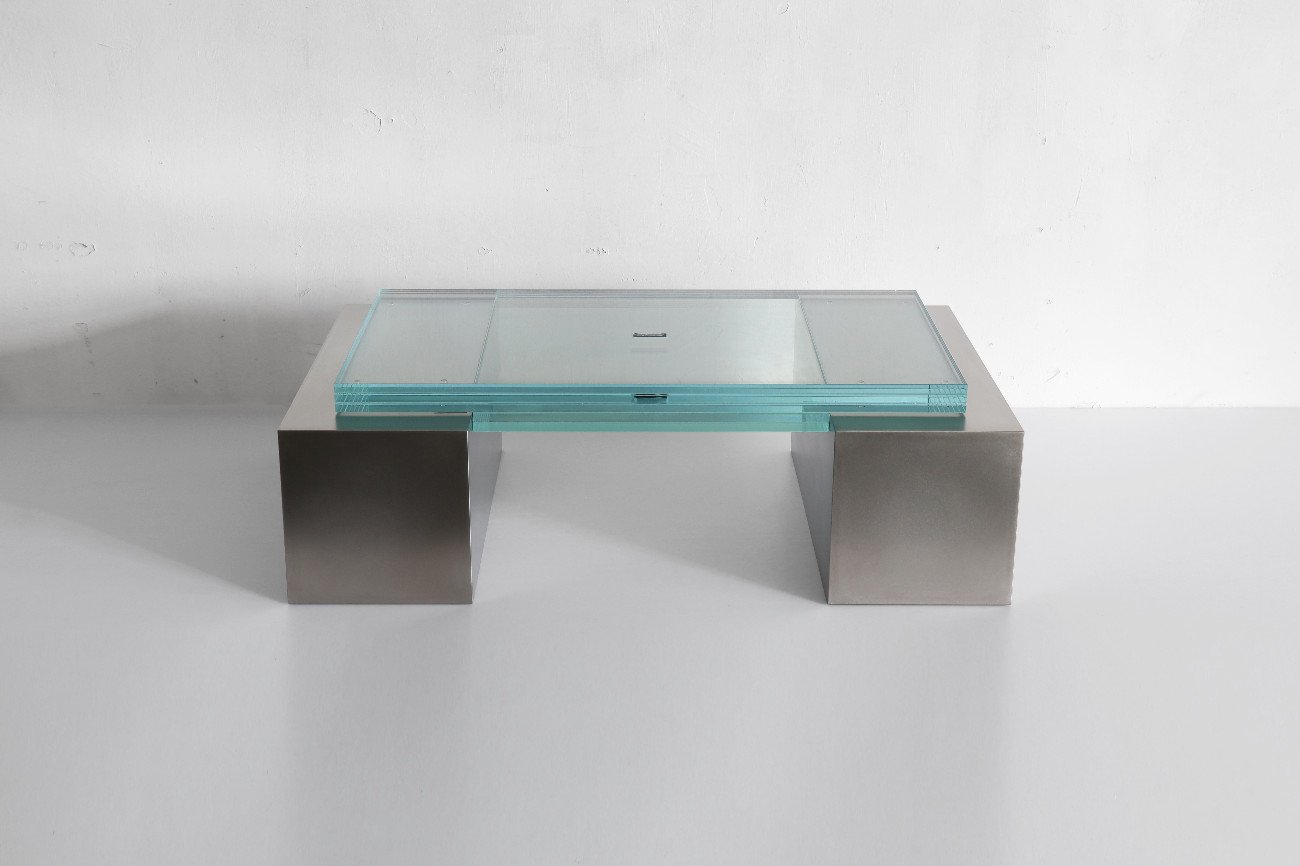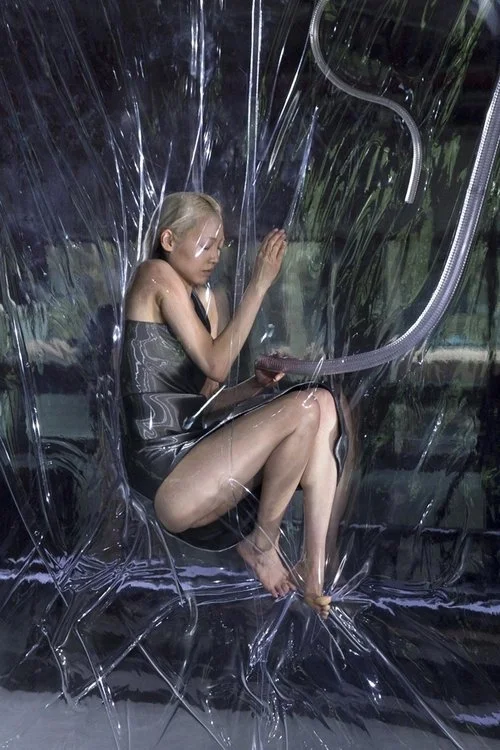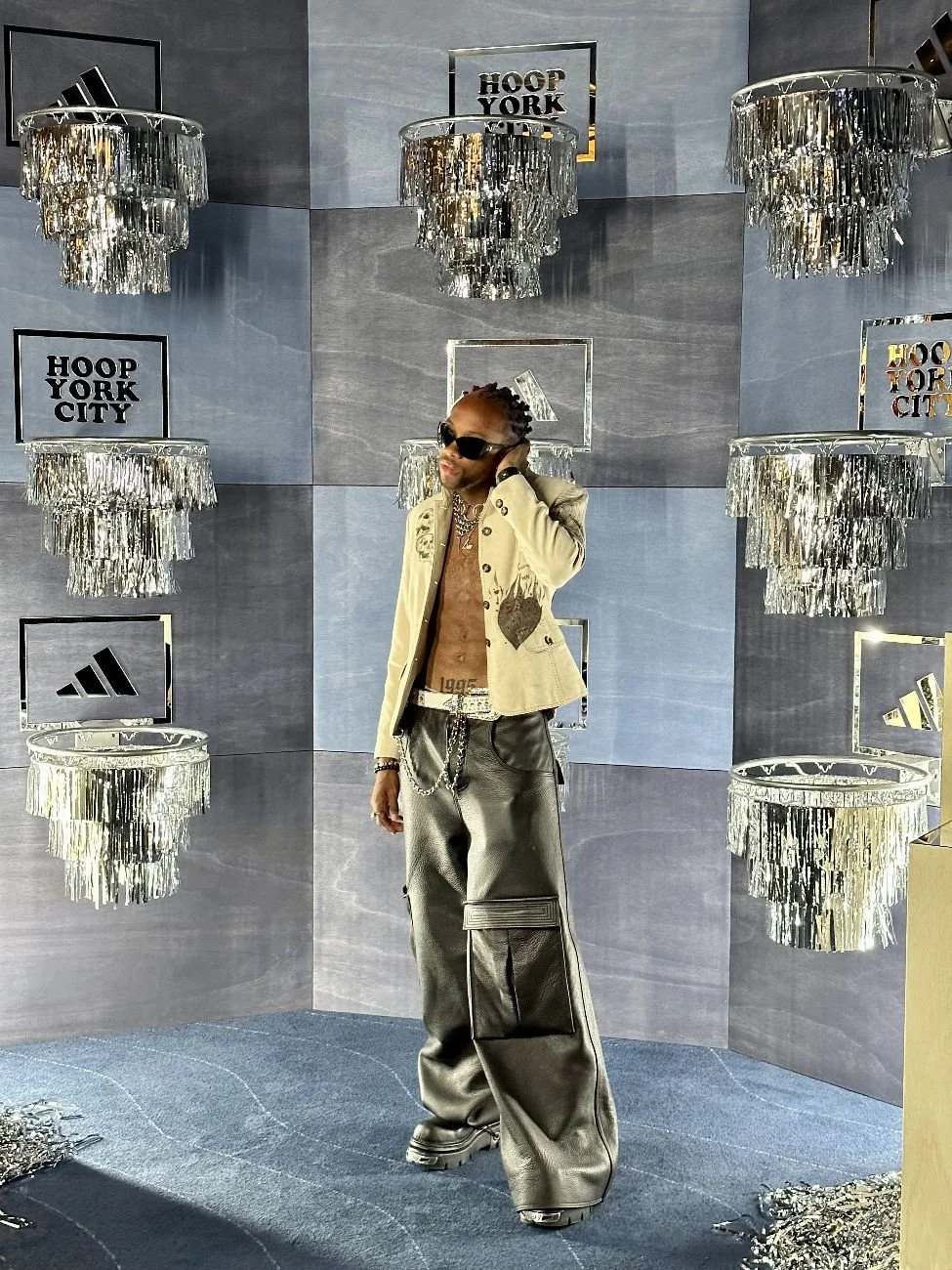Batten and Kamp
In the dynamic world of art and design, few duos capture the essence of collaborative creativity as vividly as Ali Batten and Daniel Kamp of Batten and Kamp. Their work, which blends elements of furniture and sculpture, reflects a genuine connection to nature and a thoughtful approach to material choice. This fusion not only establishes their unique artistic style but is also a constant exploration of the boundaries between art and design, showcasing a harmonious blend of practicality and aesthetic appeal.
In this interview, Ali and Daniel open up about their journey from New Zealand to Hong Kong, and now Paris, sharing insights into their personal and professional lives that intertwine so seamlessly. From discussing the impact of cultural shifts on their design aesthetics to revealing the intimate dynamics of their partnership, Batten and Kamp offer a window into the soul of their practice. Their candid conversation explores the subjects of nature, technology, and personal boundaries, shedding light on their evolving narrative and the profound relationship they maintain with their art.
Could you introduce yourselves and tell us a bit about the inception and vision of your studio, Batten and Kamp?
Batten and Kamp is the joint art practice of myself (Daniel Kamp) and my partner Ali Batten. Predominantly, we make furniture and sculptures, with most pieces being a mix of both. We started Batten and Kamp at the beginning of 2020 after many years of separate but converging creative paths that crossed over occasionally in the form of collaborative projects. Eventually it just made sense to do all our work together. We started with a grand and naive ‘manifesto’. It was a probably-necessary but totally-ignorant attempt to create some kind of concise shared idea of ‘good design’. Of course the studio has diverged slightly from that initial plan but the driving force behind what we do has really always been our relationship. We just love exploring together so we did everything we could to make that our full time jobs. Nowadays we try not to be bound but any particular vision but instead let the identity of the studio arise naturally from our interests and the resulting themes that tend to run consistently through our works.
Can you describe a typical day in your life, both personally and professionally, and how these aspects influence each other?
Talking, sketching, drinking coffee, reading, eating, making, writing, exercising, fucking, dreaming; everything influences everything else.
What motivated your move to Hong Kong, and how has this city determined your design aesthetics?
We moved to Hong Kong together from New Zealand in 2017. It’s hard to say exactly why we moved there specifically. My best guess is that we we’re done with NZ and then simply wanted to rebel against the typical move from New Zealand to the UK or Europe. We loved Asia and just kind of landed on Hong Kong intuitively, without knowing much about it and having zero connections there. We were first drawn to the cyber-punk, neon super-city, aspect of it - Something as far from what we grew up with as possible. Eventually though we discovered that this is really only one side of a ‘city of contrasts’ that is equal parts Blade Runner dystopia and vibrant tropical paradise.
The combination of these two seemingly incompatible aesthetics is something very special to that place and ultimately what kept us there as it appealed to both sides of our interests. As you might expect, this also directly informed our work. Our pieces tend to centre around the theme of the relationship between these two great forces of our time, non-human nature and humanities manipulation of that nature.
We recently relocated to Paris to work directly with Carpenters Workshop Gallery on our new collections. We’ve gone from a very new world island in the south, which is neither eastern nor completely western, to the purposefully ‘east-meets-west’ gateway of Hong Kong, to a very old world city in the west. Why we keep subjecting ourselves to these culture shocks is beyond me but I can say that the cultural clashes between our different homes are an endless source of conversation for us.
How does your romantic relationship intertwine with and influence your creative process and collaborative work?
Our creative chemistry fuels our romantic relationship and our romantic relationship drives our professional collaboration. Creativity is what we find most attractive in each other. We respect each other immensely - I’m always showing off to Ali and she’s always showing off to me. But attraction requires distance so it was very scary to merge our professional and personal lives. We thought it might all get so close that it fell apart. In reality the opposite was true. Working together has strengthened and deepend our relationship because we now share the thing that excites us the most. It has also made our work better and more interesting (from our perspective). Our work is our shared voice, our shared reality. Distance between us is now something we have to actively cultivate as not to undermine the attraction that makes it all happen, though this can be hard to remember to do because we just love hanging out together.
Nature is a recurring theme in your work. Could you share the creative process behind integrating natural elements into your pieces, and how do you choose which aspects of nature to highlight?
I was raised working on my dads farm and Ali is the daughter of two avid gardeners. We grew up with our hands in the dirt. This connection to nature is essential to us (to most New Zealanders really). However as we move through adulthood we find ourselves in increasingly less direct contact with Nature. Sometimes it’s necessary to close this gap for our mental health but we can also use this distance in our work. The distance between us and nature, our current selves and our child-selves, creates longing and leaves space for romanticisation which we convert into works.
Practically, when it comes to designing things we typically tend to something like this formula: We are best at reduction, Nature is best at complexity, we want both in our work. So in any particular piece where there are organic forms or materials, we have generally just taken them directly from nature with little intervention, and where we are ‘creating’ form (which normally happens around the organic elements) we generally employ abstract shapes and hard lines. I can't see much point in trying to create organic forms ourselves when nature has made available such beautiful specimens already.
Having said this, I just read from Rick Rubin “As soon as a rule is established the most interesting thing to do is to break it”. So next year we’ll probably work in a totally different way.
Material selection must be a pivotal aspect of your narrative. How do you match specific materials with the themes you're exploring, like relationships and nature, in your projects?
We’re more interested in nature, science and prehistory than we are in culture (which I find surprisingly uncommon among designers). Our relationship to nature is, for us, a deeply personal thing but it is also arguably the most important topic of our time. However we don’t want our works to carry opinions so we don’t intend to create anything that states what our relationship with nature should be. Instead we are just drawn to it as a general theme and explore it from different angles. So when we are choosing materials, and forms for our works we just go by what interests us.
Right now we are finding branches and flowers out in nature, digitising them and printing them in titanium or casting them in aluminium. So there’s this most basic tendency to collect beautiful things that were generated naturally by the earth (something we and other animals have been doing forever) and then there’s this kind of futile human attempt to make permanent the inherently transient. What we end up with are ghosts or memories of the forest. This can be about loss or about evolution, or these can just be pretty things that feel nice to be around, like it's nice to sit under a canopy of branches.
You've spoken about pushing boundaries between your private life and your work with 'Sex Tape.' Could you share more about the internal conversations and decision-making that led to this exploration, and how you managed the emotional aspects of merging these typically separate spheres?
This piece was scary as fuck to make. I’m still not sure if it was a good idea and at the same time I think it’s my favourite thing that we’ve done.
This was a very personal piece in that it was a tool for us to figure something out about our practice and our lives. We had been talking a lot about how present we want to be personally in our ‘brand’ or in what the world receives from us. In the beginning we accepted that in our time it’s a lot easier to have some success if you are the face of your work. But over the course of the last few years, as we got more publicity, we started to feel like it might have been nice to be totally anonymous. Of course the answer is somewhere in between but it can be hard to pinpoint exactly where.
At the same time that we we’re pondering this, our Hong Kong gallery asked us to create something for an upcoming exhibition around the theme of sex. We were sitting in our local cafe talking about what we should do when Ali was like “We should just make a sex tape and seal it in glass”. It was just a kind of intuitive outburst but was also the most direct possible response to the theme of the show while also perfectly capturing this tension we were feeling about how our audience wanted more from us than we actually wanted to give. So we just stuck with that initial impulse and embedded the sex tape in a coffee table because we liked the idea that it could sit in the centre of a home and perpetually tempt its owner. Would they destroy our artwork out of selfish desire to gain access to our inner lives?
In the end the piece has given us a lot more clarity on the boundary between our public and private lives and the answer is that there definitely is a line to be drawn between us and our audience.
Our friend recently overheard in a rave in Hanoi, “I heard about these artists that made a sex tape and sealed it in a coffee table”. People have also stopped us in the street and said “Hey you made that Sex Tape thing right”. It's insane to me to think that people who we’ve never met actually talk about our work like that and it feels great to have made a piece which people find that interesting. Although it’s a strange feeling to be known for your own sex tape, even if no one has seen it.
With pieces like 'Comfort Seeker Seeker', you're blending cutting-edge technology with classic design. What is your overarching philosophy on the role of technology in art and design?
We have no particular philosophy about design, art, or technology. We just find these things and their confluence interesting. Sometimes I think that our technologies and our architecture are just another beautiful part of nature (like, is a beehive unnatural?) other times they seem totally at odds with nature and I find them terrifying. Who knows what's right. Of course we’re not proposing this piece as part of a potential future we’d actually like to live in (contrary to the hilariously literal interpretation of some IG commentators). But we’re also not saying that AI and robotics have no place in our domestic lives. We’re just trying to express this paradoxical mix of the aesthetic attraction that we feel to these technologies and the vague sense of dread that they bring about in us
Are there any projects you dream of undertaking that you haven't had the opportunity to explore yet?
For now we are pretty content in our discipline of functional art and the scale of furniture. There's a lot of room for expression and because the objects are human-sized, people seem to relate to them. However we are excited to keep expanding the scale of our exhibitions and continue to mix furniture, sculpture and installation. Ali’s background is in architecture and before Batten and Kamp I also worked on lots of interiors. We have no intention to go back into that world but perhaps eventually doing a kind of ‘Batten and Kamp house’ would be fun. Something where we create the space and fill it out as a complete expression of our universe. Perhaps at home in Aotearoa, in the forest. Some kind of shining, alien, architectural intrusion among the trees, in the rain and the dirt.
interview JULIANA NEIRA
What to read next























